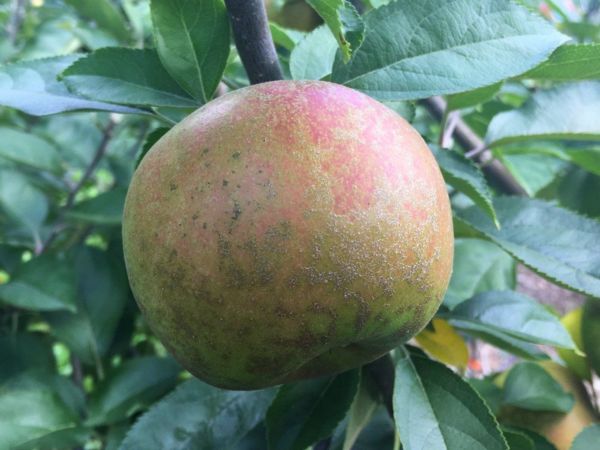An attractive, highly disease-resistant apple, ideal for organic growers.
Orleans Reinette Apple Scionwood (Spring 2024)
An unusually flavored, disease-resistant apple from the 18th century . Also known as Winter Ribston, Orleans.
A hardy, and moderately vigorous tree, Orleans Reinette does best in warm locations. It is a triploid and two diploid pollenizers should be present for full fertility. The tree has an upright habit and it will need to be thinned to maintain annual bearing. Though this is usually considered a broadly disease-resistant tree, the USDA notes high fireblight susceptibility.
The apple is medium sized, wide and squat, with some ribbing at the calyx end. The skin is beautifully burnished with a net of fine russeting laid over its red and gold skin. It has a glowing antique look to it, like a polished brass doorknob. The yellowish flesh is fine textured and crisp, and it has an unusual, perfumed flavor that has won plenty of praise over the years. Typically described as "orange and nuts," the flavor has made Orleans Reinette a favorite dessert apple in France, and in 1929 Edward Bunyard wrote that it was "highest in my esteem." It does not store well for more than a month or two, but if you want to enjoy the unique flavor through to spring, it makes an excellent drying apple.
The origin of Orleans Reinette is not clear. It is usually thought to come from France, and it is first described in 1776, but it may be considerably older. In Apples for the 21st Century, Manhart notes its resemblance to the ancient Court Pendu Plat.
Volume Pricing
| Quantity | Orleans Reinette Apple Scion |
|---|---|
| 1 | $12.00 |
| 2-5 | $7.00 |
| 6-10 | $6.00 |
| 11-99 | $5.00 |
| 100+ | $4.00 |
The Fruit
Fruit Type
Category: Apple
Subcategory:
Heirloom, Hot-Climate
Fruit Uses & Storage
Uses: fresh eating
Storage duration: one to three months (approximate, depending on storage conditions)
Fruit Appearance
Skin color: gold
Flesh color: cream
Fruit Origins
Parentage: unknown
Origin: France (probably)
Introduced in: 1700s
Introduced by:
The Environment
Calendar & Geography
USDA zones: 5 - 8
Chill hours: Not yet determined
Ripening date: Oct 06 (approximate, in New York State) + 21 days after McIntosh
Diseases & Pests
glossary
Apple Scab: Resistant
Cedar-Apple Rust: Resistant
Fireblight: Susceptible
Powdery Mildew: Resistant
Pollination
Pollination Factors
glossary
Bloom group: 4
Is it self-fertile? N
Is it fertile? N
Ploidy: Triploid
Pollination Partners
This table shows the first few results from a full search for pollenizers of Orleans Reinette Apple. Please see our Pollenizer Search to run other queries and read how the application uses various factors. Also read more about fruit tree pollination.
| Tree | Currently in Stock |
|---|---|
| Virginia Crab Apple | 0 |
| Florina Apple | 0 |
| Porter's Perfection Apple | 0 |
| Elstar Apple | 0 |
| Rubinette Apple | 0 |
| St. Edmund's Russet Apple | 0 |
| Spitzenburg Esopus Apple | 0 |
| Liberty Apple | 0 |
| Mother Apple | 0 |
| Binet Rouge Apple | 0 |
| Freyberg Apple | 0 |
See all pollination matches for Orleans Reinette Apple
Featured Products
A few things we're loving right now...
A full-flavored, freestone white peach.
One of America's oldest apples, good for storage, baking, and cider.
A widely-grown, large, yellow-fleshed nectarine.
















